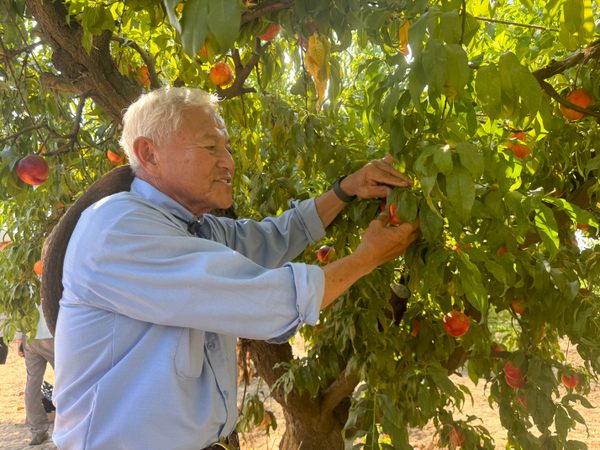Masumoto Family Farm is a fourth-generation Japanese-American farm outside of Fresno, California, run by David “Mas” Masumoto and his daughter, Nikiko. The family focuses on growing heirloom stone fruits and grapes, steered by their belief that, above all else, fruit should taste amazing. That seems like an obvious goal, but in the modern market, durability and appearance have long trumped flavor in the produce aisles. So by growing delicious heirloom varieties, the Masumotos are making a radical choice. And with no guaranteed commercial buyers, they often have to rely on equally radical systems to sell their fruit. That’s why, 20 years ago, Mas decided to tread new ground to save the Elberta peach—an almost-extinct heirloom stone fruit—by creating his Adopt-a-Tree Program.
When I first learned about the Elberta peach, it was described to me as “a peach so juicy you have to eat it over the kitchen sink.” That was how Peter Ruddock, president of Slow Food California, explained it at the Slow Food annual conference and festival in 2019. I thought, I need to meet this peach! But it would be years before I would stand in an orchard of Elbertas, juice dripping down my chin, on the first day of the annual Adopt-a-Tree harvest.
A combination of a U-Pick and a CSA, the program accepts applications each year in January. A team leader must write an essay about why they want to adopt a tree, commit to coordinating a group of 6 to 12 people, and promise to travel to the Masumoto farm on a TBD date—typically two consecutive weekends in July or August—to harvest their fruit. If a team is accepted, they pay an $850 fee to “adopt” an Elberta peach tree or $800 for a Le Grand nectarine tree, another heirloom variety on offer. The teams follow their tree’s progress over six months: Nikiko sends photos and updates from the orchard. Then, after carefully watching for the signs, Nikiko and Mas send an email announcing the harvest dates. Travel plans can be made only a few weeks in advance; of the 49 teams this year, some live locally, others came from San Francisco or Los Angeles, and one team flew in from Hawai’i.
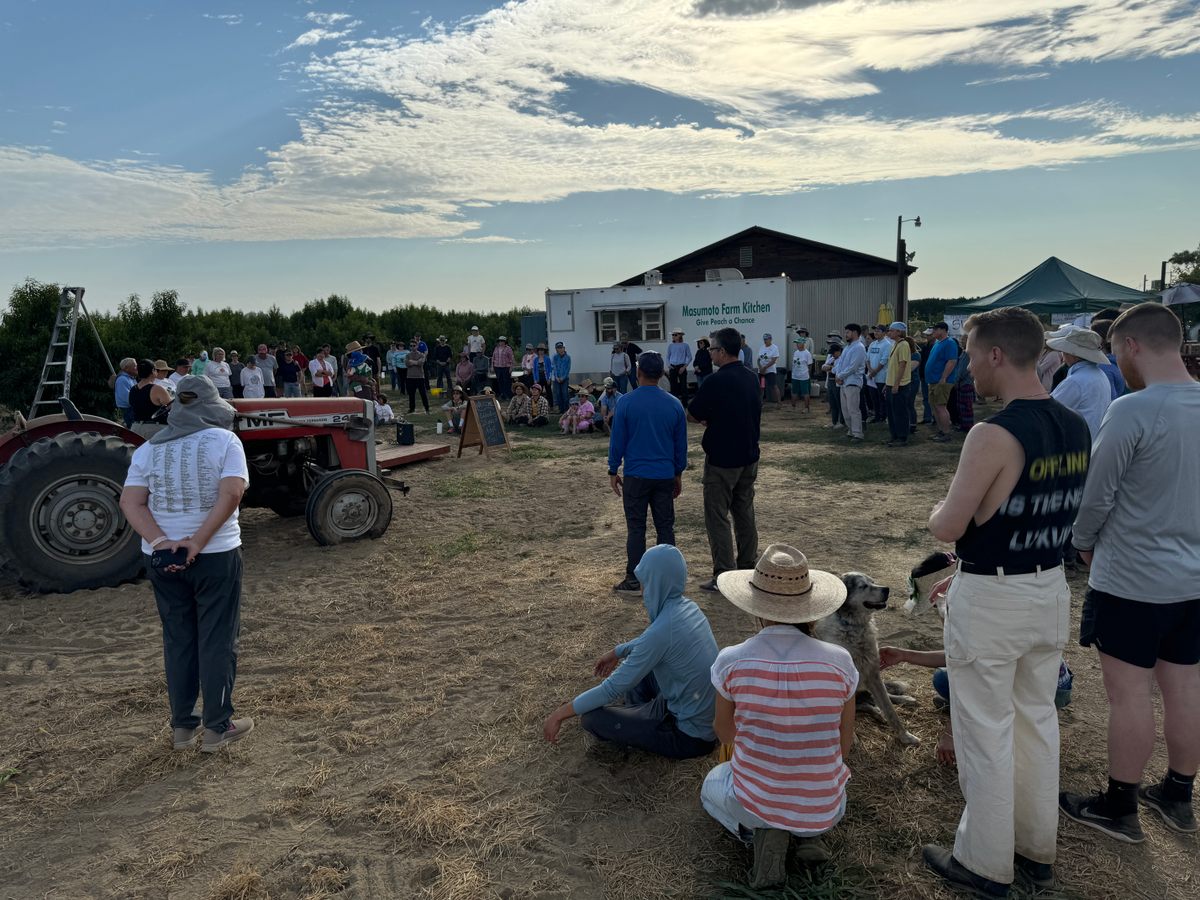
Flying into Fresno in August 2024, I noticed that the rows of fruit trees on the ground below were so orderly, like a Lego set snapped into place. On the ground—when I drove to the Masumoto farm the next morning—it was more like a tunnel, grapevines on my left, endless peach trees on my right. Or, as Nikiko later described them, a “cathedral of memory.”
A dusty farm road led me to the Masumotos’ special Adopt-a-Tree orchard. The joy was palpable. Nikiko and Mas checked in a caravan of cars, welcoming back participants they see every year and meeting babies coming with their parents for the first time. An aloof, black-and-white farm dog carefully inspected each new vehicle. The parking lot—a dusty field—was already half full at 7:30 a.m., teams grabbing baskets out of their trunks and heading into the tree line to find their adopted tree out of the orchard of 150. The peach trees on this side of the orchard were literally dripping with fruit, limbs touching the ground under the weight of this year’s bumper crop burden.
When it was my turn at the front of the line, I rolled down my window, letting in the smells of dust and ripe peaches. I was greeted by Mas at check in. At 70, Mas bursts with energy. His eyes crinkled with smile lines, and he was often smiling in the orchard that day. Mas gave me the lay of the land via a hand-drawn map—Elberta peaches on this side, tables set up for lunch in the orchard’s center, and rare Le Grand Necatarines on the far side. Before I pulled away, I asked him: Why devote his life to these trees, why the Elberta?
“They were heirloom varieties that no one was planting anymore,” Mas told me. “This adoption saved them.”
Around the turn of the 20th century, the Elberta was the most widely grown peach in the United States. Developed in Georgia by grower Samuel E. Rumph, the peaches made their commercial debut in 1875. At the suggestion of a friend, Rumph named them after his wife, Clara Elberta. A bright golden peach with a neon-red blush and orange flesh, the fruit’s greatest advantage was that it could be harvested underripe and slightly firm, which made it durable for shipping by train. What’s more, the peaches did not need to be iced during shipping—a key advantage in an era when ice was costly if it was even available. The Elberta peach ripened in transit, making it perfectly sweet and luscious once it reached Northern markets like New York City.
Rumph and his Elberta peach are credited with kicking off Georgia’s peach industry, and making the “Georgia Peach” famous across the country. In 1897, a prominent Georgia orchardist, Colonel John D. Cunningham, told Harper’s Weekly, “Two things that have done so much for the Georgia peach growing industry are the introduction of the Elberta peach and the use of the improved refrigerator car,” the latter of which was introduced in 1880s. And an 1896 article on Rumph’s first plantings in American Agriculturalist Magazine declared, “Among the whole list of peaches both old and new there is no variety that has attained a higher place in public estimation than the Elberta.”
But by the mid 20th century, other varieties came on the market that had slim advantages over the Elberta. They lasted even longer in storage and they didn’t have a pointed tip at the bottom of the fruit, like the Elberta, that got crushed in transit. And peach aesthetics changed: Produce sellers felt a more uniformly red peach was more appealing, so the blushed and dappled Elbertas were discarded.
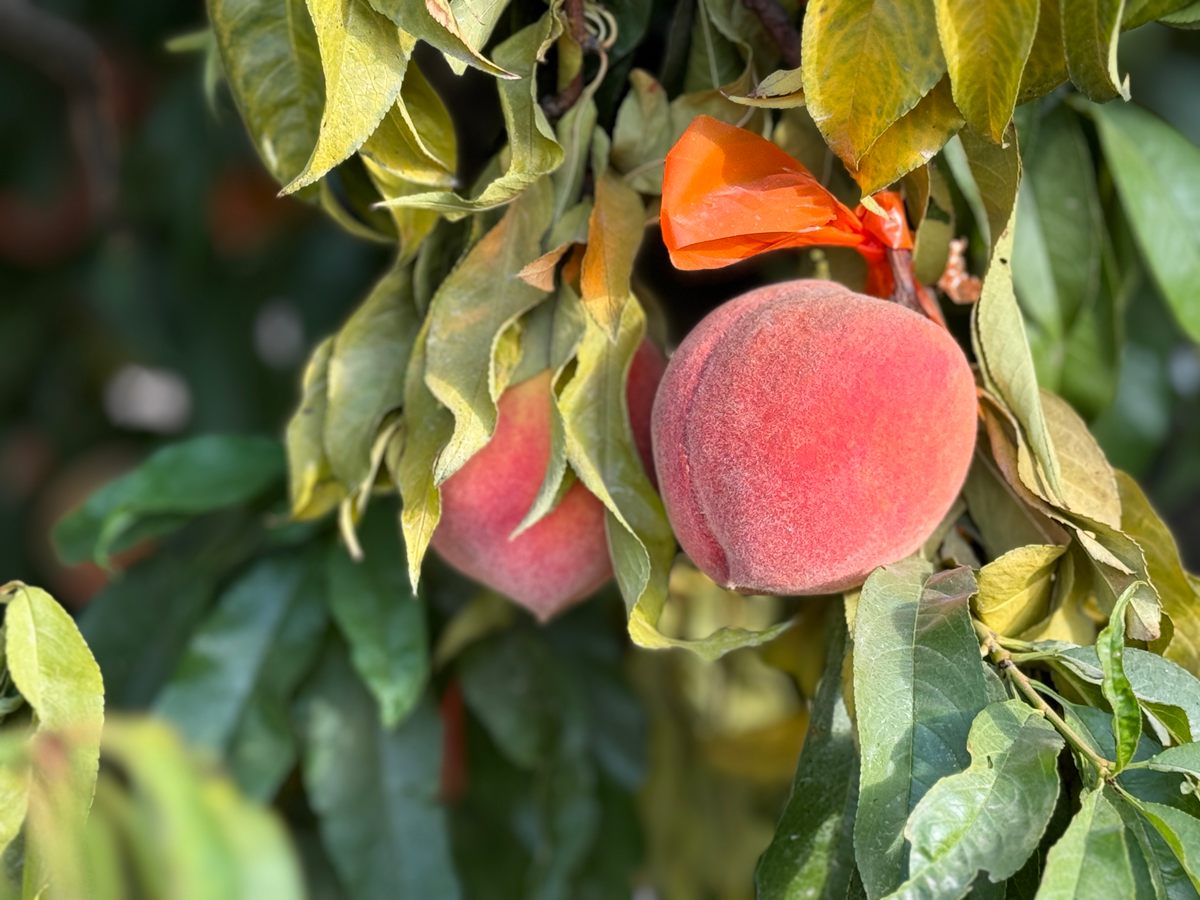
As I wandered into the rows of Elberta trees in August, I paused at a team of young couples, accompanied by a blonde toddler busy gnawing a peach. The team, named Weldon Avengers and Friends, was led by the toddler’s mom, Sarah Sharpe. They lived in Fresno.
“I’ve wanted to do this forever and could never afford it,” Sarah told me. “Then during the pandemic, I got really close with all my neighbors, so we formed a team.” They now adopt four trees annually; this year, a bumper crop for the fruit, they would take home and divide up around 1,600 pounds of peaches.
“Do you want to try one? I’ll rinse one off for you.” Sarah poured water from her sticker-covered water bottle over a peach, and gave it a gentle scrub with her hands. That was good enough for me. I held the peach up to my face and let the soft fuzz touch my lips, tasting the smell before I bit into the flesh.
I wish I could share the taste of that peach in the field with you, freshly freed from its tree, sun-warmed and scented by the grass, dirt, and the thousands of ripening peaches around it. There is no peach that can taste like that one, even if it were the same peach eaten over the kitchen sink—although that one would be delicious, too. The deep orange of the peach’s interior was tart and sweet with a bit of bitterness from the peel. I had to suck the juice from the fruit as I pulled away and it still ran down my chin. The flavor was honey on my tongue.
These are peaches that make you feel alive.
My hands and mouth sticky with peach juice, I watched Sarah’s team start to sort the fruit. The peach triage started in the field for all the teams and it was a feat of supreme organization. Bruised peaches that had already dropped to the ground would have to be prepped and cooked as soon as the team members got home; peak ripe fruits still on the branch were for eating that day, sometimes before even leaving the field; and yellow-green peaches that were still slightly underripe, but would be too far gone by the next weekend, would continue to ripen at home, on the kitchen counter.
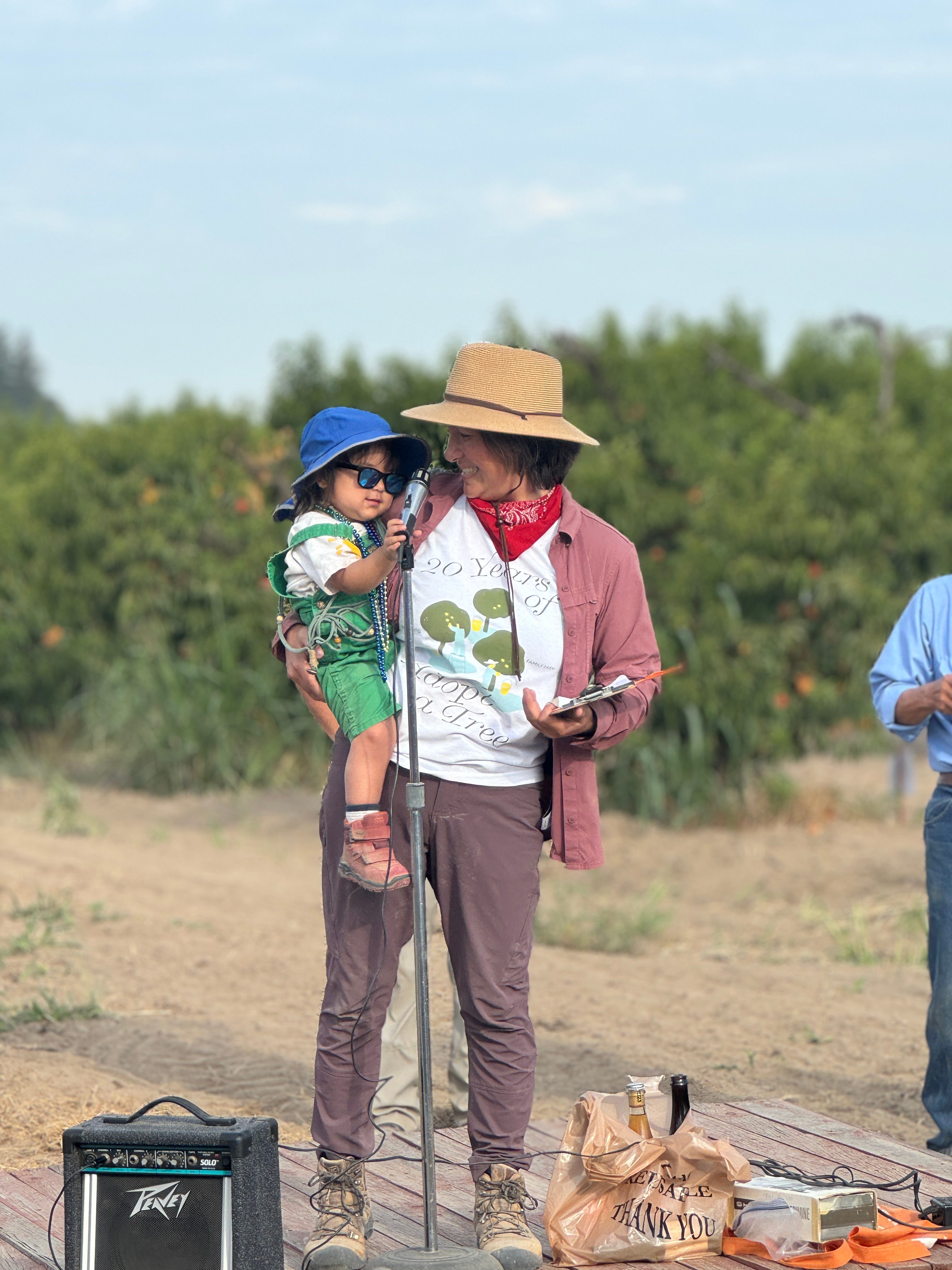
The morning in the orchard had started breezy and overcast, but by 8:15 a.m., when Nikiko and Mas began their morning orientation, the sun was out and sweat was running in rivulets down my back. Nikiko led a quiet reflection for the assembled teams. The Adopt-a-Tree program was celebrating its 20th anniversary this year, and while some teams had been coming that long, others were there for the first time.
“What does 20 years mean?” Nikiko began. At 38, her smile was as broad as her father’s, and she addressed the crowd with her baby balanced on her hip. “That probably means all of us have experienced some shared things. All of us have probably experienced falling in love in 20 years, whether it’s romantic or with a new family member. Probably some of us know new children who exist, who did not exist 20 years ago. I also think that 20 years probably means all of us have lost someone that we really loved.
“I hold both the joys, the people, the babies, the newness, with the people who are gone, because that’s what we do as farmers. We are stewards not only of the food that nourishes our bodies, but the stories that keep us linked together, as humans linked to ancestors and to all the hopes that we have for the future.” Nikiko asked us to close our eyes, imagine a lost loved one—perhaps cooking in the kitchen—as well as what we might look like in 20 years, with new wrinkles and grown children, perhaps still coming back to pick peaches on this farm.
Nikiko passed the mic to her mom, Marcy, who read the brunch menu that would be served at tables in the orchard starting at 9:30. There would be a salad with fresh Le Grand nectarines and pulled pork with a homemade peach chutney. Then, Mas shared that there would be a tasting of beers made from the farm’s stone fruits. He asked the longest-attending teams to gather for a photo, while Nikiko gathered newbie teams to train them how to safely use the fruit-picking ladders, tripods especially designed for uneven orchard ground.
The gathered teams were groups of friends, extended family, and work colleagues. Several restaurants and a bakery sent teams, including Tomat and Fat + Flour in L.A. and Waterbar in the Bay Area. Waterbar is one of the teams that have been a part of this program the longest, since 2009. Like many of the teams, Waterbar found their way to the Masumotos through Mas’s 1995 memoir, Epitaph for a Peach: Four Seasons on My Family Farm. It was written during the first decade Mas took over the farm from his parents, in the early 1990s, when he made his unorthodox decision to prioritize flavorful fruit, all while starting a young family. His love of his fruit, farm, and family, expressed in those pages, inspired many people to reach out and apply for the Adopt-a-Tree program.
“We discovered just how magical the Masumotos and the fruit they grow actually are,” Eric Hyman, Waterbar’s purchasing director, told me over email. In the 15 years that Waterbar has been participating in the program, Hyman wrote, “We’ve brought dozens of team members to the Masumotos’ home and harvested thousands and thousands of pounds of amazing stone fruit. We’ve also shared meals together, swam in their pool, and hosted the family at Waterbar for a party to celebrate the release of their cookbook.”
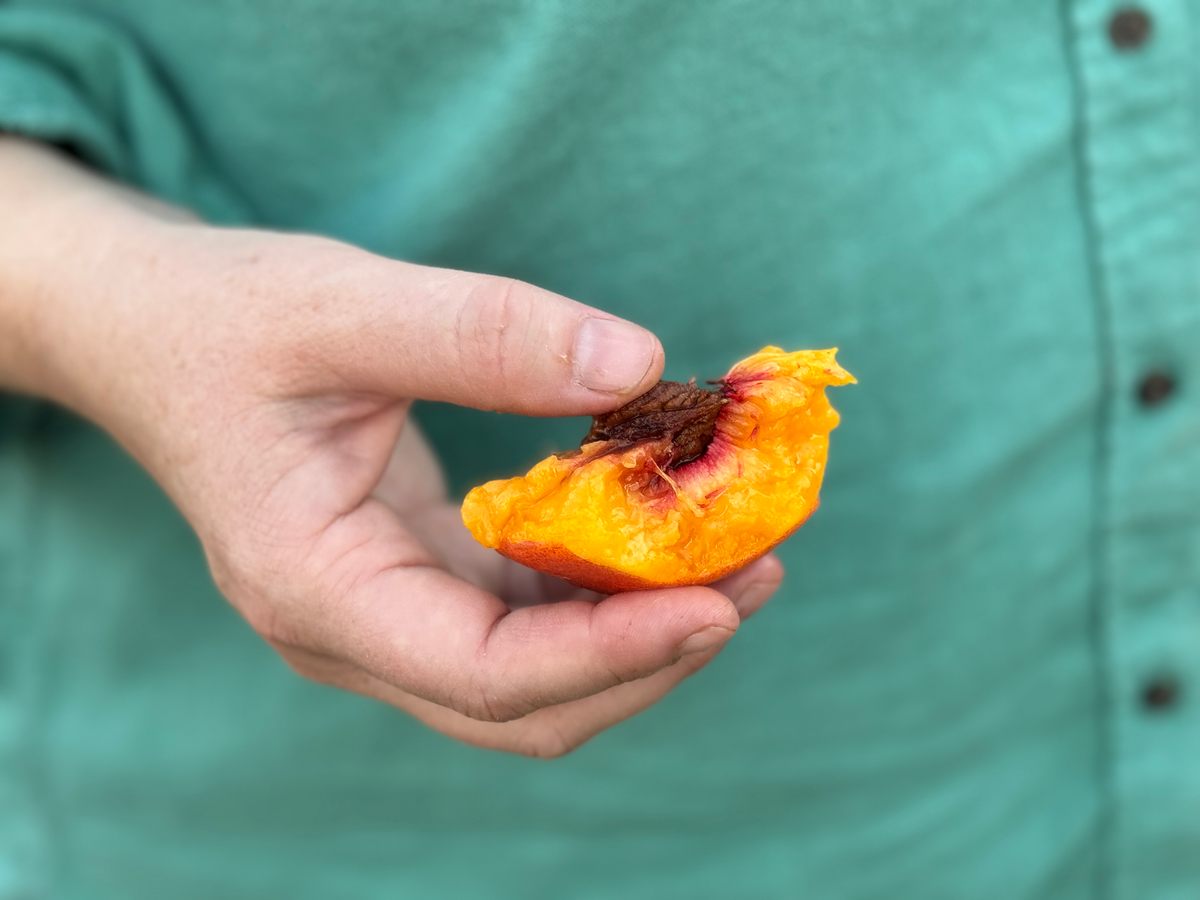
The Elberta peach would show up on Waterbar’s late-summer menu in the form of Elberta Peach and Heirloom Tomato Salad, Oak-Roasted Broccolini with Elberta Peaches and Mascarpone, and a Warm Peach & Blueberry Crisp with Burnt Basque Cheesecake Ice Cream. In past years, Waterbar has experimented with a Fermented Peach Gochujang, Elberta Peach–Infused Whiskey, and even a Peach Leaf Ice Cream, the cream itself infused with Elberta peach leaves.
But whenever I asked teams what brought them back, year after year, the first thing they would mention is the Masumotos themselves. Mas and Marcy; Nikiko and her brother, Koreo; and now Nikiko’s wife, Nichola, and baby girl, Nunziata.
“On the surface level, the fruit is what brings us together,” Nikiko told me when we caught up over Zoom after the first harvest weekend. “And at the same time, the fruit is really just a symbol or a vessel for being alive together and connecting.”
Nikiko’s grandparents—Mas’s parents—had bought the original 40-acre farm in 1948, right after they were released from an internment camp. Their parents had emigrated from Japan and become farm workers, but the California Alien Land Law of 1913 barred immigrants from owning land in the state. Since there was no way to prevent American-born children of immigrants from buying land, Mas’s parents, then in their 20s, took a huge risk and invested in the land where the Adopt-a-Tree orchard now grows. Both generations worked the farm together, just as Mas and Nikiko work the land together now.
“They loved us unconditionally and worked so hard to build a home from the rubble of racism,” Nikiko said of her ancestors. Nikiko never met her great-grandparents, but they planted grapevines on the property that she still harvests from. “They literally planted roots for us, for me, and we get to be alive and harvest from the same plants they planted, that they tended to.”
Some of the teams at the orchard in August also had a connection to the long history of Japanese-American culture in California. A group of retired school teachers from the L.A. area (team name: “m-m-m momo,” a play on the Japanese word for peach) has been coming to the Adopt-a-Tree event for 11 years. They are all sansei, third-generation Japanese-Americans, and grew up in Central and Southern California. Diana, the team leader, was drawn to the orchard not only by Mas’s book, but by her own personal connection to the Elberta peach.
Diana’s father was a fruit retailer. “And so I knew Elberta peaches, and I loved them,” she told me as we stood in the shade of the team’s adopted tree, the rest of her team picking and sorting peaches around us. “He would just bring boxes home.” After Elbertas disappeared from the market, she missed their flavor. So participating in the program has been very sentimental for her. “It’s the taste memory,” she said.
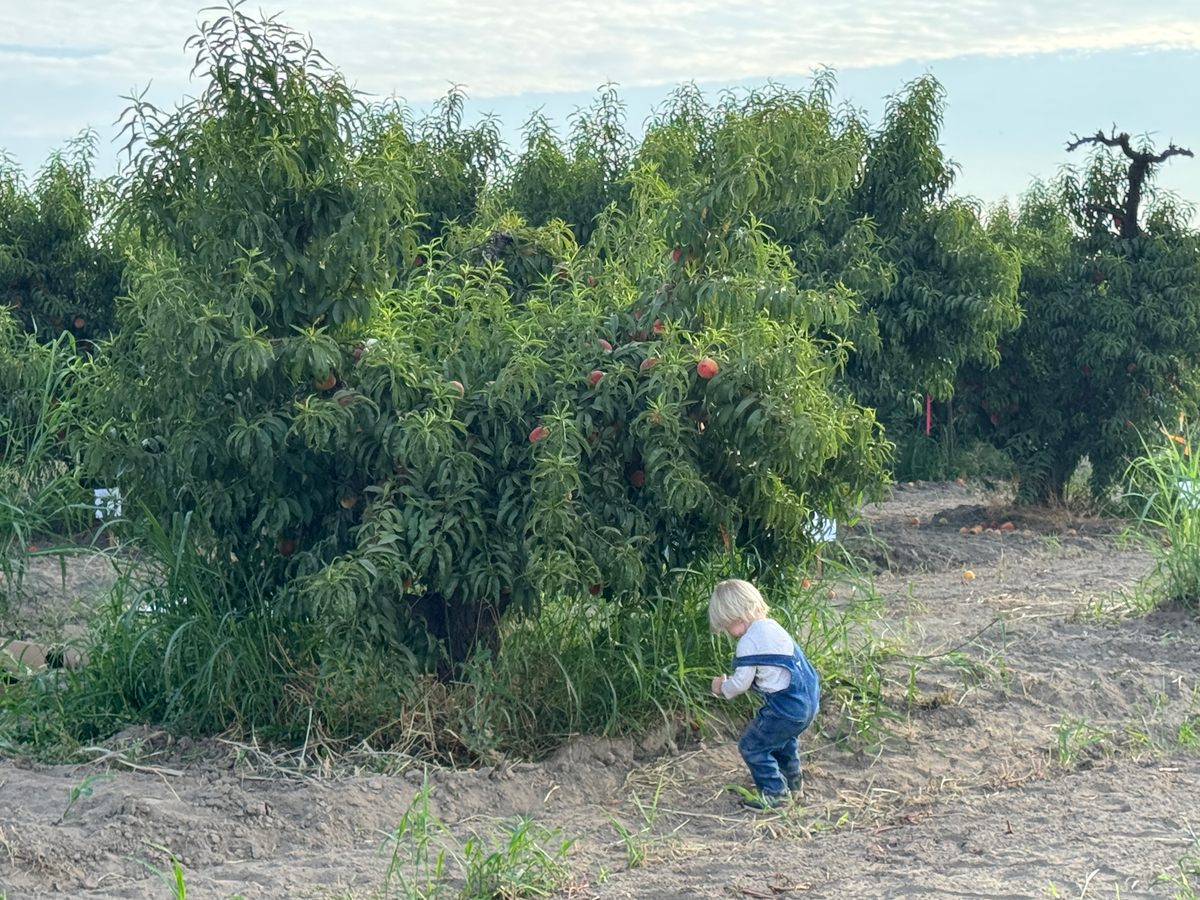
The peaches are sentimental for the Masumotos, too. Epitaph for a Peach begins with a lament for another delicious peach, the Suncrest. Despite their incredible flavor, by the 1990s, fruit buyers no longer wanted them. Mas writes, “When ripe, they turn an amber gold rather than the lipstick red that seduces the public. Every year the fruit brokers advise me to get rid of those old Sun Crests. ‘Better peaches have come along,’ they assure me. ‘Peaches that are fuller in color and can store longer.’” The family’s fruit broker advised Mas to dump the crop, because the boxes they were shipped in were worth more than the fruit.
“My dad was so deep in grief about losing this orchard,” Nikiko told me. “He had already scheduled the bulldozer to take out the Suncrest.” To process these feelings, he wrote an essay, “Epitaph for a Peach,” which would later become the first chapter of his book. After the Los Angeles Times published the essay, Mas received letters from locals who remembered the delicious peaches and begged him to keep growing them.
“I was a baby,” Nikiko’s voice caught as she told me the story, hundreds of miles away, over our Zoom call. She was near tears. “Especially now that I’m a parent, I understand the pressures of ‘How am I gonna provide for this human who is my responsibility?’ And so with these letters in hand, my dad literally told the bulldozer to stop—went out into the fields and said, ‘Stop.’”
He stopped the bulldozers without a plan. But the first year, he was able to sell his fruit to an organic baby-food processor. Then, a Japanese-American fruit buyer who went to college with Mas came on as their fruit broker. In the mid-1990s, Chez Panisse, Alice Waters’s game-changing restaurant in Berkeley, became interested in Masumoto’s Suncrest, seasonally serving a single, perfect peach as the dessert course of their prix fixe menu. After that, the Masumoto’s Suncrest peaches developed a cult following.
In her 2017 memoir, Coming to My Senses, Waters specifically calls out Masumoto’s fruit when discussing what goes into producing a perfect peach: “If the right varietals are planted in the right spots, they can be the greatest peaches of all—like a Suncrest peach in August from Mas Masumoto’s farm in the foothills of the Central Valley.”
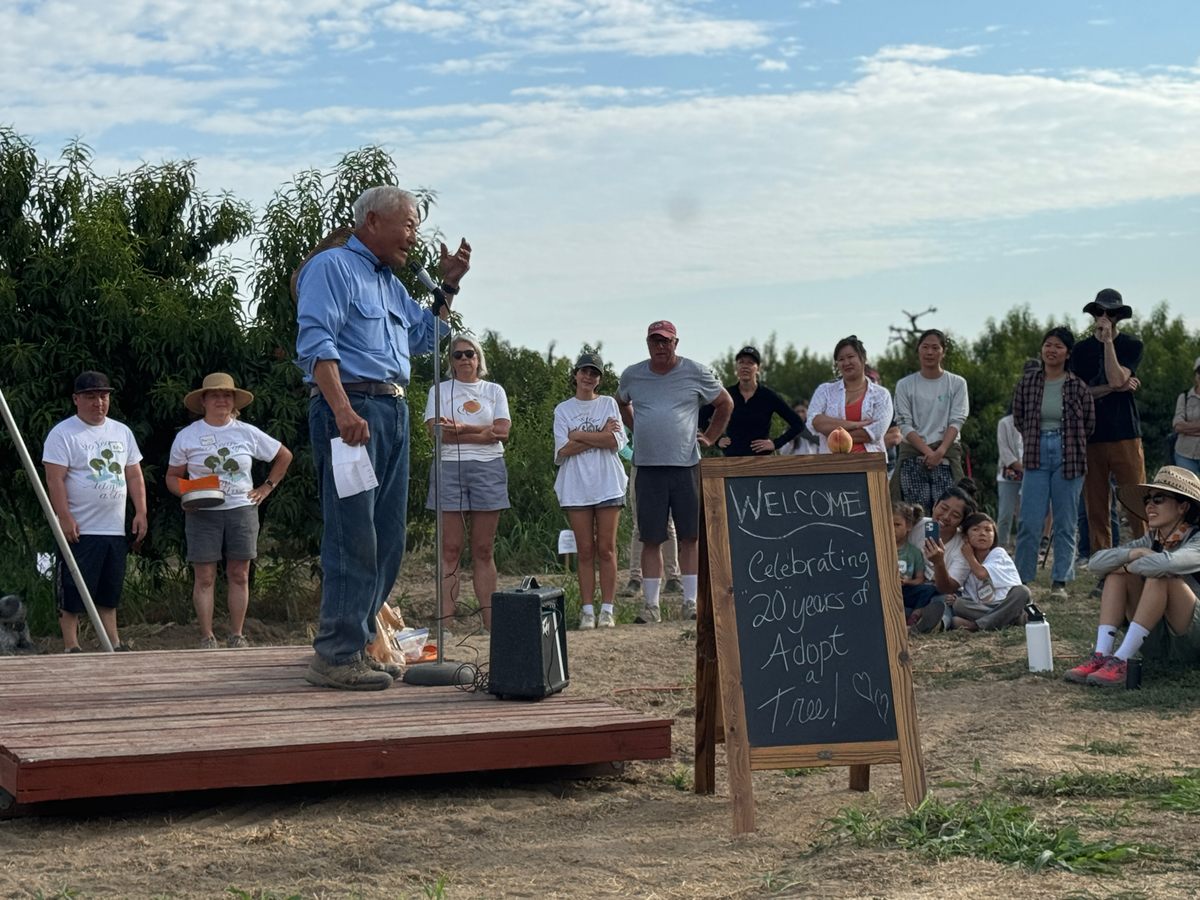
“It’s so moving to me that we were this close to being a completely different operation and losing these trees. I mean, if I had a religion, Suncrest would be it,” Nikiko told me. The success of the Suncrest meant the Masumotos saw the potential in saving other delicious stone fruits, like Elberta peaches and Le Grand nectarines. They developed a mission that focused on connecting the people eating their fruit back to the orchard, the family, and the land.
“There was really something fundamentally pedagogical about what my mom and dad wanted to do,” Nikiko told me. “That’s why it’s an Adopt-a-Tree. Like, you are so invested in this tree that you are thinking of it as your family member.”
Ironically, while Mas turned the bulldozers back on his Suncrest peaches 30 years ago, he made the decision to pull out an orchard of Le Grand nectarines. The Le Grands were out of fashion because they are “clings,” meaning their flesh clings to the pit instead of easily separating. Non-cling fruits are now sold almost exclusively in supermarkets.
“My dad couldn’t gamble on it all…We had bills to pay,” Nikiko said. “Getting to graft the Le Grande back is absolutely this full circle moment.”
Le Grands are now offered through the Adopt-a-Tree program. To get to the nectarines, I just had to cross to the other side of the orchard. The teams there seemed even more excited about their fruit, if that was possible.
Sarah Shaw was the leader of a five-person team that had driven from the Bay Area that morning, hitting the road at 4 a.m. They’ve attended almost every year since 2016 to harvest Le Grande Nectarines. “We came one year right after we got married,” Shaw told me. “And the Masumotos had left all these little sweet notes all over our tree.”
“It was so sweet,” her husband chimed in. “All this poetry.”
“Now we have a new team helper,” Sarah added. “This is Clara.” She gestured to a tiny girl, focused on scooping the loose orchard dirt into organized piles.
I asked Sarah why she preferred Le Grands. “They’re so luscious,” she said. “They fill your mouth in a nice way. You would have never have thought it would be that sensual of a texture. In the weeks leading up to this, I’ve been dreaming of that texture.”
As her team carefully sorted peaches by size and ripeness in boxes, Sarah reflected on the abundance of each year’s harvest. “When you’re here and you go home with this many fruits, more than you could ever need, to share with all your friends and family and neighbors … it’s just such a sweet opportunity to be like, Look at what the world can provide. These trees are just like dripping with the most delicious food in the world.”
Almost on cue, a nearby tree dropped a heavy nectarine, dense with sweet juice. It hit a patch of grass with a padded thud, ready to be collected and consumed.
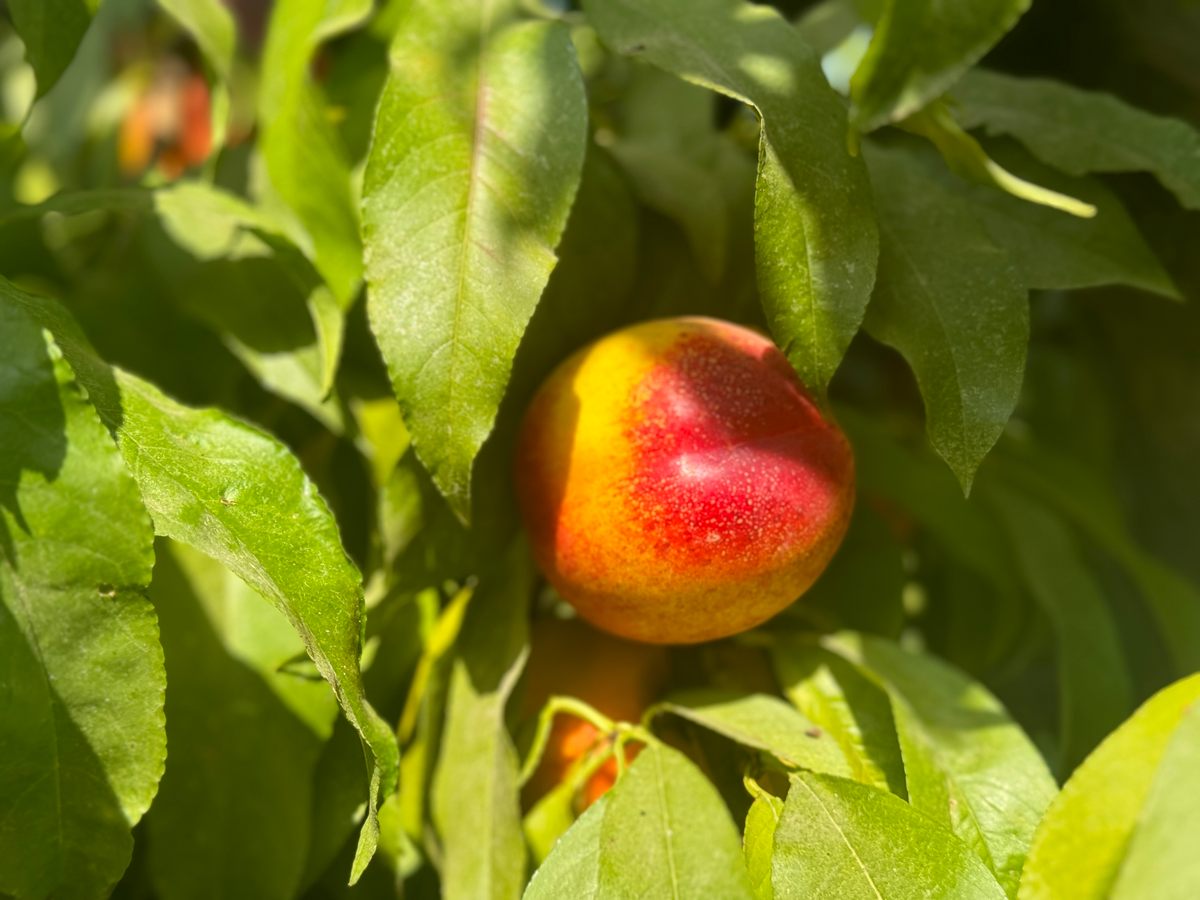
In Epitaph, Mas wonders, “Perhaps salvation for my peaches will become a family affair.” When Mas wrote his book, he was about 40 years old and at a turning point, raising toddlers, working with his elders, and trying to envision what the next 20 years of farming might look like. Now, Nikiko stands at the same crossroads of intergenerational farming and the uncertainty of the future.
Nikiko had a very clear epiphany that led her to farming in the first place. She was at the University of California, Berkeley, majoring in women’s studies. To fulfill a science requirement, she took an environmental studies class. “One guest lecturer came to give a talk about the impacts pesticides were having on our water, soil, and the health of our people, both farm workers and eaters. And I was in awe because I had never considered what growing up on an organic, small, family farm meant in a global context of power. My family were growing things with an ethic and a philosophy of stewardship. They were making a radical choice about the world that they wanted to see.”
The course offered an extra credit writing assignment that asked “What are you going to change about your life based on this class?”
“I sat in front of my laptop and I really thought about it,” Nikiko told me, reflecting on that moment. “And that’s when I decided the most courageous thing I could do with my life would be to go home.”
“Every year I feel like I peel back another layer of meaning of what it means to live and work in an intergenerational space,” Nikiko said. “The dirt, the tractors, the trees, the vines—they are part of my molecules, like part of my being.”
Gastro Obscura covers the world’s most wondrous food and drink.
Sign up for our regular newsletter.
